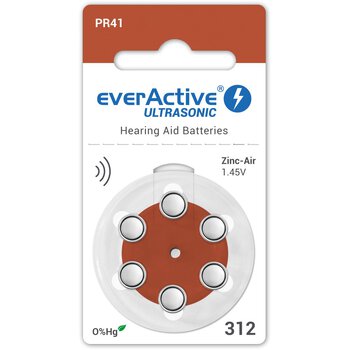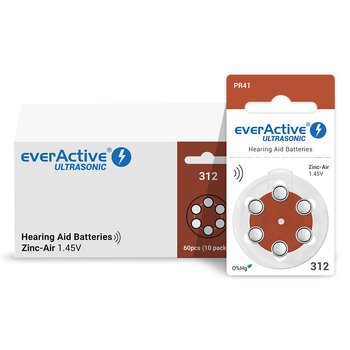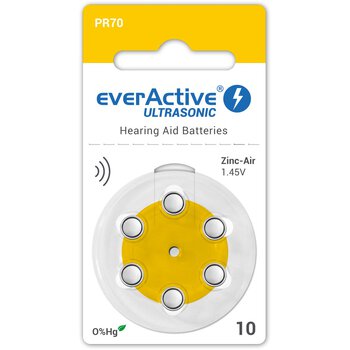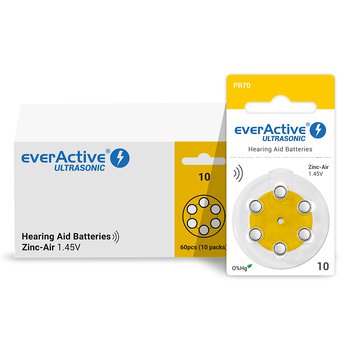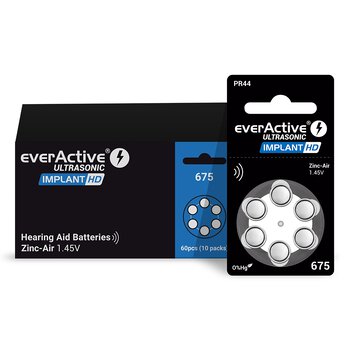- Tips
- technology
- Frequently Asked Questions
- Tests
- mAh capacity
- Rated Capacity
- everActive
- comparison
- Durability of rechargeable batteries
- Efficiency of rechargeable batteries
- battery voltage
- Accumulated energy
- Batteries vs rechargeable batteries
- LR03 AAA
- LR6 AA
- eneloop
- AG13 LR1154 LR44
- Delta V
- Charge Cycles
- internal resistance
- charge level
- CR 2032
- memory effect
- accredited test
- SR44 357
- Hearing Batteries 675
- SR626 377
- Watch Batteries
- Polarity
- Mah
- passivation
- LS 14250
- LS 14500
Using Hearing Batteries - Frequently Asked Questions
How long does a hearing aid battery last?
Unfortunately, due to the diverse range of devices in which batteries are used, the answer cannot be clear. A standard hearing aid battery allows you to use the device from 3 to 22 days. This period depends on the energy demand of the equipment, the specific type of battery (e.g. large 675 zinc-air batteries have the longest operating time), as well as the intensity of use of the hearing aid or implant, or the prevailing environmental conditions.
Read also our post: What factors affect the operating time of zinc-air batteries
How often should I change my hearing aid battery?
Some hearing aids and implants may indicate that the battery needs to be replaced – this can be an audible signal to let you know that the battery is running low.
If the camera does not have this functionality, change the battery if the sound quality has deteriorated or the camera requires higher volume settings.
Your batteries, after a period of use, can drain very quickly. It's good to have a set of spare batteries with you at all times.
Prevent battery drain. Peel off the protective sticker and aerate the battery immediately before placing it in the hearing aid or implant. Also, avoid contact between the battery and metal objects. It is a good idea to get a handy battery box.
What is the battery sticker for a hearing aid or implant?
It protects the zinc-air battery from discharging. When the sticker is broken, the contents of the battery react with oxygen from the air and from that moment on, it is gradually discharged. Always buy batteries with an undamaged sticker.
When replacing the battery with a new one, peel off the protective sticker from the new battery, wait 2 minutes and only then place the new battery in the hearing aid.
How to limit battery drain?
- Turn off the camera if you are not using it. You can open the place where the battery is placed to limit its use (unless the device manufacturer does not recommend it).
- Remove the battery from the device if you will not use it for a long period of time. Remember that zinc-air batteries will gradually discharge when the protective sticker is removed.
- Avoid extreme (high and low) temperatures.
What else should I pay attention to?
- Store batteries in their original packaging at room temperature.
- Wash your hands before placing the batteries in the camera. Contamination can negatively affect its life.
- Leave the battery compartment in your camera open overnight to allow it to drain. Moisture can corrode your batteries.
- Immediately remove used batteries from the device. Used batteries can damage your camera.
See also our video material:
Copyright ? Baltrade
Popular hearing batteries in the hurt.com.pl store
30 x everActive ULTRASONIC 312 hearing batteries
- reliable zinc-air batteries for hearing aids
- voltage: 1.45V
- Environmentally friendly batteries - mercury-free (0% Hg)
- expiry date: min. 2028
30 x everActive ULTRASONIC 10 hearing batteries
- reliable zinc-air batteries for hearing aids
- voltage: 1.45V
- Environmentally friendly batteries - mercury-free (0% Hg)
- expiry date: min. 2028
30 x everActive ULTRASONIC IMPLANT HD 675 hearing batteries
- A rugged, high-current version of the 675 battery with enhanced performance
- dedicated to cochlear implants and speech processors
- voltage: 1.45V
- Environmentally friendly batteries - mercury-free (0% Hg)
- expiry date: min. 2028
-
Od dawna używam baterii do swojego aparatu postępuję ściśle ze wspomnianymi wskazówkami

